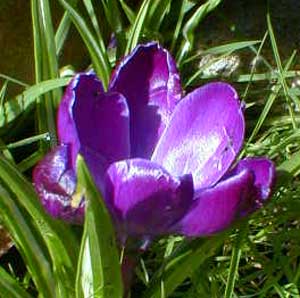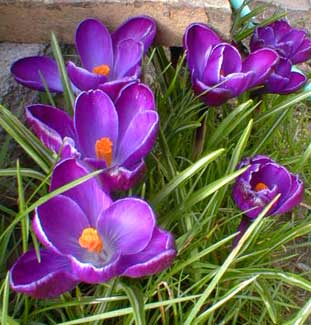
'Twlight'
Vernal Crocus
"The shrilly whinnyings of the team of Hell,
Ascending, pierce the glad & songful air,
And all at once their arch'd necks, midnight-maned,
Jet upward thro' the mid-day blossom. No!
For, see, thy foot has touch'd it; all the space
Of blank earth-baldness clothes itself afresh,
And breaks into the crocus-purple hour
That saw thee vanish."
-Alfred Lord Tennyson
1809-1892
1809-1892
Crocus vernus is the largest crocus, from which many "Dutch Giant" or "Large Flowering" varieties were developed. The natural range of the species includes Italy, Austria, Czechoslovakia, Hungary, Poland, Romania, Ukraine, & the Slavic states of the Balkans.
A typical wild form would be white with purple pencil-stripes, but it has several subspecies & color variants over its extensive range, including strikingly purple wild forms. More importantly for gardens, it has scads of marvelous cultivars which were achieved by preserving sports & cross-pollinating the various subspecies. Truly wild forms are almost never available for gardening, the many bright cultivars having so overwhelmed the original species throughout the nursery trade.
 Because this species' cultivars are so large, they're among the most common crocuses planted in turf, as they easily compete with grass & make quite a showing. They like a bit of watering even after summer die-back, & so do not rot away in watered-lawn conditions.
Because this species' cultivars are so large, they're among the most common crocuses planted in turf, as they easily compete with grass & make quite a showing. They like a bit of watering even after summer die-back, & so do not rot away in watered-lawn conditions.If they are used in this manner, however, they don't always naturalize as well as if they are given a location that is unmowed. To naturalize & spread they should not be mowed, but should be permitted to go dormant naturally, their leaves yellowing toward spring's end after strengthening the corm. Mowing the lawn at its highest setting, rather than short-grass setting, might in some cases permit C. vernus cultivars to last years in lawns & possibly increase.
Cultivars of C. vernus are frequently categorized a "snow crocuses" such as in colder zones (down to Zone 4 or even 3) will bloom while snow is still upon the ground. On Puget Sound (Zone 8) 'Twilight' begins flowering early in March & in a good year can last into April. This is well after the majority of snow-crocuses such as the many C. chrysanthus cultivars which are in their full glory for February; so I would personally exclude 'Twilight' from the snow-crocus category of January & February bloomers, & regard it as a true spring bloomer even if it does often bloom a week or two before spring officially begins.
The photo above was snapped in late-morning sun on March 4th (2005), the very first one to flower amidste sod, though by that same afternoon there were a half-dozen of these blooms opened. 'Twilight's' March or early April blooms are among the darkest violet-blue of any crocus, with a lighter purple in the throat. The large blooms stand anywhere from three to five inches tall.
Full sun meadow conditions are to their liking. Although they will also thrive in partial shade, the bloolms will not fully open except when in full sunlight, & will remain closed even on overcast days.
Corms are planted in autumn three inches deep & three inches apart. They can be planted a bit deeper in areas where mice or squirrels have learned to dig up bulbs, crocuses being more to the liking of rodents than are tulips or narcissi. C. vernus corms are quite a bit larger than for most crocuses, & each mature corm produces multiple flowers.